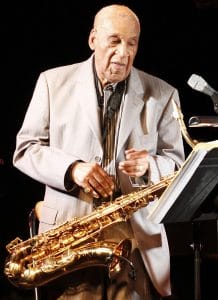As a child, Singer was taught violin, but as a teen he switched to clarinet, and then his final instrument of choice: tenor sax. Singer was born in the “Greenwood District” of Tulsa, Okla. — a “freedom colony” of African Americans that thrived: it was known as “Black Wall Street” …which was burned to the ground by racists in the 1921 Tulsa Race Massacre when Singer was 2 years old; hundreds were killed, and the city passed severe zoning restrictions to keep the district from rebuilding. As a boy, Singer hung out at the railroad depot, hoping to meet musicians from “both sides of the tracks” as they came and went to play gigs. “A lot of the top black bands came by,” said his wife, Arlette. “Since his mom was a good cook he would invite them to dinner with his parents. He told me that when he got to New York he already knew a lot of musicians because they’d been to his house for dinner.” It was a good move: Singer was invited to play with the R&B and jazz greats, including Hot Lips Page and Duke Ellington, and as a session musician in recording studios. His single “Corn Bread” was a number-one R&B hit in 1948. People started calling him “Cornbread” — but he preferred his own name.

